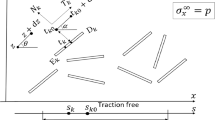Abstract
This paper pursues the study of crack kinking from a pre-existing crack emanating from some notch root. It was shown in Part I that the stress intensity factors at the tip of the small initial crack are given by universal (that is, applicable in all situations, whatever the geometry of the body and the loading) formulae; they depend only on the `stress intensity factor of the notch' (the multiplicative coefficient of the singular stress field near the apex of the notch in the absence of the crack), the length of the crack, the aperture angle of the notch and the angle between its bisecting line and the direction of the crack. Here we identify the universal functions of the two angles just mentioned which appear in these formulae, by considering the model problem of an infinite body endowed with a notch with straight boundaries and a straight crack of unit length. The treatment uses Muskhelishvili's complex potentials formalism combined with some conformal mapping. The solution is expressed in the form of an infinite series involving an integral operator, which is evaluated numerically. Application of Goldstein and Salganik's principle of local symmetry then leads to prediction of the kink angle of the crack extension. It is found that although the direction of the crack is closer to that of the bisecting line of the notch after kinking than before it, the kink angle is not large enough for the crack tip to get closer to this line after kinking, except perhaps in some special situations.
Similar content being viewed by others
References
Aliabadi, M.H., Rooke, D.P. and Cartwright, D.J. (1987): Mixed-mode Bueckner weight functions using boundary element analysis. International Journal of Fracture 34, 131–147.
Amestoy, M. (1987): Propagation de fissures en élasticité plane. Thèse de Doctorat d'Etat, Université Pierre et Marie Curie, Paris, France.
Amestoy, M., Bui, H.D. and Dang Van, K. (1979): Déviation infinitésimale d'une fissure dans une direction arbitraire. Comptes-Rendus de l'Académie des Sciences de Paris 289B, 99–102.
Amestoy, M. and Leblond, J.-B. (1992): Crack paths in plane situations – II. Detailed form of the expansion of the stress intensity factors. International Journal of Solids and Structures 29, 465–501.
Andersson, H. (1969): Stress intensity factors at the tips of a star-shaped contour in an infinite tensile sheet. Journal of the Mechanics and Physics of Solids 17, 405–414.
Bilby, B.A. and Cardew, G.E. (1975): The crack with a kinked tip. International Journal of Fracture 11, 708–712.
Fett, T. and Munz, D. (1997): Stress Intensity Factors and Weight Functions, Computational Mechanics Publications, Southampton, UK.
Goldstein, R.V. and Salganik, R.L. (1974): Brittle fracture of solids with arbitrary cracks. International Journal of Fracture 10, 507–523.
Gross, B. (1970): Some Plane Problem Elastostatic Solutions for Plates Having a V-Notch, Ph.D. Thesis, Case Western Reserve University, USA.
Hasebe, N. and Iida, J. (1978): A crack originating from a triangular notch on rim of a semi-infinite plate. Engineering Fracture Mechanics 10, 773–782.
Isida, M. (1979): Tension of a half-plane containing array cracks, branched cracks and cracks emanating from sharp notches. Transactions of the Japan Society of Mechanical Engineers 45, 306–317.
Leblond, J.-B. (1989): Crack paths in two-dimensional situations – I. General form of the expansion of the stress intensity factors. International Journal of Solids and Structures 25, 1311–1325.
Mouchrif, S.-E. (1994): Trajets de propagation de fissures en mécanique linéaire tridimensionnelle de la rupture fragile. Thèse de Doctorat, Université Pierre et Marie Curie, Paris, France.
Muskhelishvili, N.I. (1952): Some Basic Problems of the Mathematical Theory of Elasticity, Noordhoff, Leiden, the Netherlands.
Sha, G.T and Yang, C.T. (1985): Weight function calculations for mixed-mode fracture problems with the virtual crack extension technique. Engineering Fracture Mechanics 21, 1119–1149.
Wilson, W.K. (1969): On Combined Mode Fracture Mechanics, Research Report 69-1E7 FMECH-R1, Westinghouse Research Laboratories, Pittsburgh, USA.
Wu, C.H. (1978): Elasticity problems of a slender Z-crack. Journal of Elasticity 8, 183–205.
Author information
Authors and Affiliations
Rights and permissions
About this article
Cite this article
Leblond, JB., Mouro, P. Crack propagation from a pre-existing flaw at a notch root – II: Detailed form of the stress intensity factors at the initial crack tip and conclusion.. International Journal of Fracture 104, 223–237 (2000). https://doi.org/10.1023/A:1007637416241
Issue Date:
DOI: https://doi.org/10.1023/A:1007637416241




